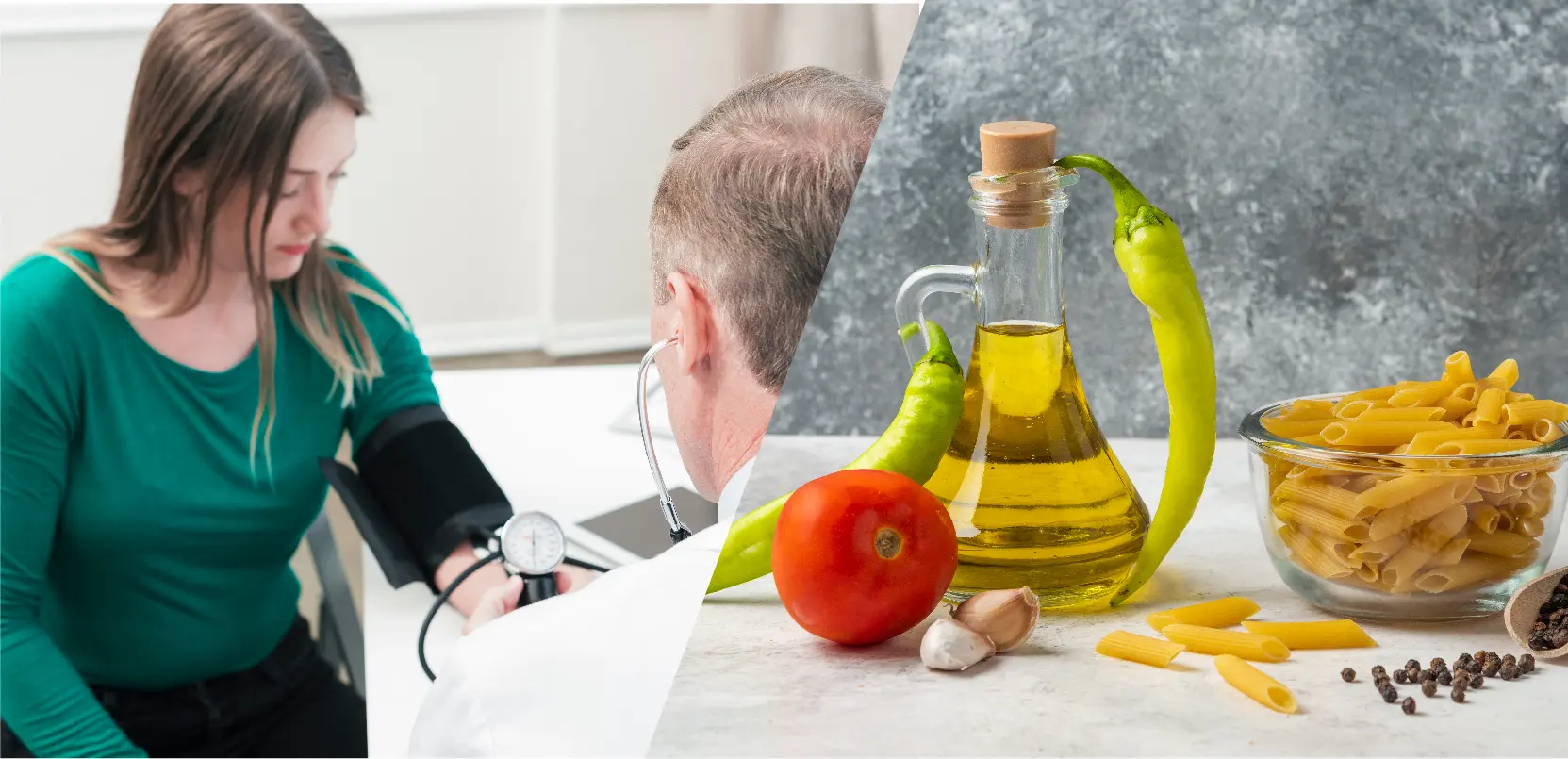

You might not see it coming—a common meal, seemingly innocuous, yet capable of pushing your blood pressure to worrying heights. In every kitchen lurks a potential culprit, contributing silently to a national health crisis.
CDC statistics show that nearly half of U.S. adults, 48.1% to be exact, grapple with hypertension. It’s time we turned our attention to the unsuspecting foods contributing to this condition. Surprisingly, a mere 22.5% of those affected have their blood pressure under control. Join us as we unveil the common foods that are silently pushing your blood pressure beyond the brink.
Before diving into the specifics of how certain foods can influence your blood pressure, it’s crucial to understand the foundational role that diet plays in managing and potentially improving this critical aspect of your health.
Hypertension, or high blood pressure, acts as a silent threat, often going unnoticed until it precipitates more severe health complications such as heart disease, stroke, and kidney damage. Given its stealthy nature, proactive management is key, and this is where diet emerges as a powerful ally.
The foods we consume can have a profound effect on blood pressure levels, either contributing to its rise or assisting in its control. A heart-healthy diet can reduce the risk of hypertension development and support the effective management of existing high blood pressure.
This is not just about avoiding salt or sodium, which is commonly advised, but about embracing a comprehensive approach that includes the intake of a wide range of nutrients known to support heart health and blood pressure regulation.
Salt, or sodium chloride, is a staple in kitchens worldwide, but its pervasive presence in our diets goes far beyond the salt shaker. Often lurking in processed and prepared foods, salt is a prime suspect in the quest to understand factors that lead to increased blood pressure. Stats say that Americans consume almost 3,400 milligrams (mg) of sodium per day, on average. While a dash of salt can elevate the flavor of a dish, it’s the excessive intake of salt-enriched foods that poses a significant risk to cardiovascular health.
Consuming high amounts of sodium can disrupt the natural balance of minerals in your body, impairing the kidneys’ ability to remove water. This results in higher blood pressure due to the increased strain on your blood vessels. Over time, this additional strain can weaken blood vessels and contribute to heart disease, stroke, and kidney problems.
High-sugar foods, or as we might more enticingly call them, “Sweet Temptations,” play a leading role in the drama of rising blood pressure and deteriorating heart health. These delectable yet deceiving treats encompass a wide range of foods, from the apparent candies and desserts to the more insidious sugar-sweetened beverages and even some “healthy” packaged snacks. The allure of these sweet indulgences is undeniable, but so are the health risks they carry, particularly when it comes to our cardiovascular well-being.
While sugar does not contain sodium, its impact on blood pressure is more indirect but equally concerning. Consuming large amounts of added sugars can lead to weight gain and obesity, which are significant risk factors for hypertension. Moreover, high intake of sugary foods can cause a spike in insulin levels, leading to increased heart rate and narrowed arteries. Over time, these effects can contribute to higher blood pressure levels, setting the stage for more serious cardiovascular conditions.
When it comes to dairy products, their relationship with blood pressure is a tale of nuance and moderation. Within this category, chocolate and specifically its variations—such as dairy milk chocolate and dark chocolate—hold a particular interest due to their widespread popularity and debated health implications.
Chocolate, particularly dark chocolate, has been the subject of much interest and research in relation to blood pressure. This is because cocoa, the key ingredient in chocolate, contains flavonoids, which are compounds known to improve heart health by enhancing blood flow and relaxing blood vessels. However, the question arises: does chocolate raise blood pressure, or can it actually be beneficial?
Studies suggest that dark chocolate, rich in cocoa solids, can have a positive effect on blood pressure, thanks to its high flavonoid content. Moderate consumption of dark chocolate has been associated with slight reductions in blood pressure, attributing to its potential vasodilatory effects.
The answer lies in the type and amount of chocolate consumed. While dark chocolate in moderation might be beneficial, excessive intake, especially of milk or white chocolate, which contains higher amounts of sugar and fats, can contribute to weight gain—a risk factor for hypertension.
Beyond chocolate, the broader category of dairy products also requires a balanced approach. Low-fat dairy options, such as milk, yogurt, and cheese, have been shown to be part of a healthy diet that can support blood pressure reduction, thanks to their calcium, potassium, and magnesium content. These nutrients play a role in blood pressure regulation, making low-fat dairy a beneficial choice for those managing hypertension.
Snacks, by themselves, do not inherently increase blood pressure. However, the type and content of the snacks we choose can significantly influence our cardiovascular health. Many conventional snack options are laden with salt, saturated fats, and added sugars, all of which are dietary culprits known to affect blood pressure levels adversely.
Excessive salt intake, a key factor in many processed and packaged snacks, can lead to fluid retention, placing additional pressure on the blood vessels and consequently raising blood pressure.
Found in high-fat snack foods, saturated fats can contribute to the buildup of arterial plaque, narrowing the arteries and requiring the heart to work harder to pump blood, thus elevating blood pressure.
When it comes to managing high blood pressure, your diet plays a pivotal role. Making conscious food choices can significantly reduce the risk of hypertension and its associated health complications. It’s not just about avoiding foods that can raise blood pressure; it’s equally important to incorporate foods that can help lower it.
Magnesium is a crucial mineral that plays a role in over 300 enzymatic reactions in the body, including the regulation of blood pressure. It helps to relax blood vessels and improve blood flow. Incorporating magnesium-rich foods into your diet can be a step towards better blood pressure management.
Potassium helps counteract the effects of sodium and eases tension in the blood vessel walls, which can lower blood pressure. A diet rich in potassium is essential for maintaining electrolyte balance and normal blood pressure levels.
A high-fiber diet can help improve blood pressure by helping to reduce overall blood cholesterol levels, thereby supporting healthy blood vessel function. Fiber-rich foods also help you feel full longer, aiding in weight management.
In tackling high blood pressure, the secret lies in the choices we make at the dining table. It’s a game of dodging the hidden dangers in our meals—too much salt, the sneaky sugars, and understanding the dairy dilemma—while embracing the food that are good for our health like: foods rich in magnesium, potassium, and fiber. This isn’t just about steering clear of certain foods but also about filling our plates with the ones that fight for our heart’s health.
In essence, managing blood pressure is less about denying oneself and more about making smarter, informed choices. By opting for heart-friendly snacks and incorporating nutrient-packed staples into our diets, we take proactive steps not just towards controlling blood pressure, but in celebrating a life of vibrant health. It’s a journey of balance, awareness, and the joy of discovering that the best medicine might just be on our plates.
Talk to an Expert Now